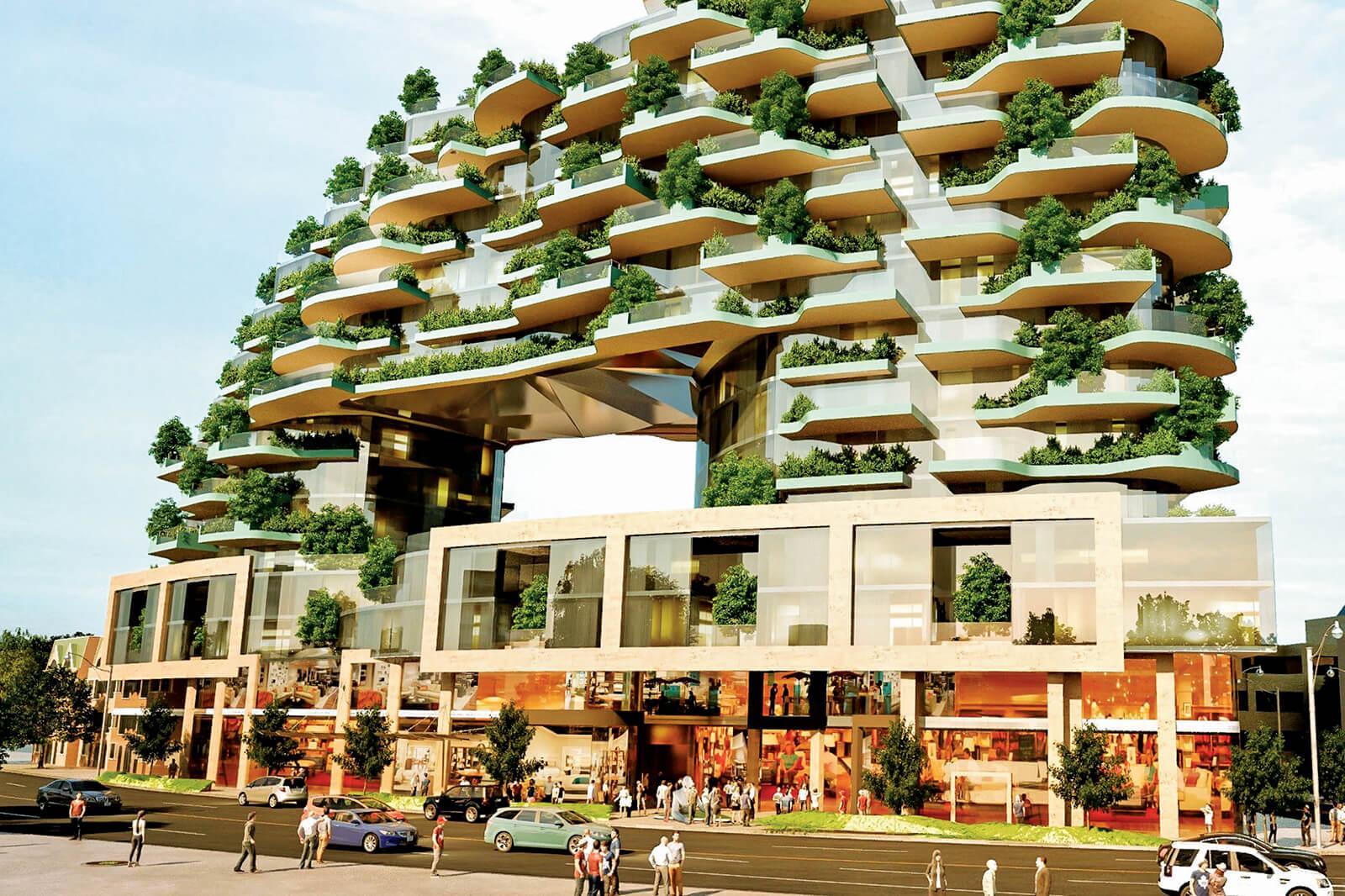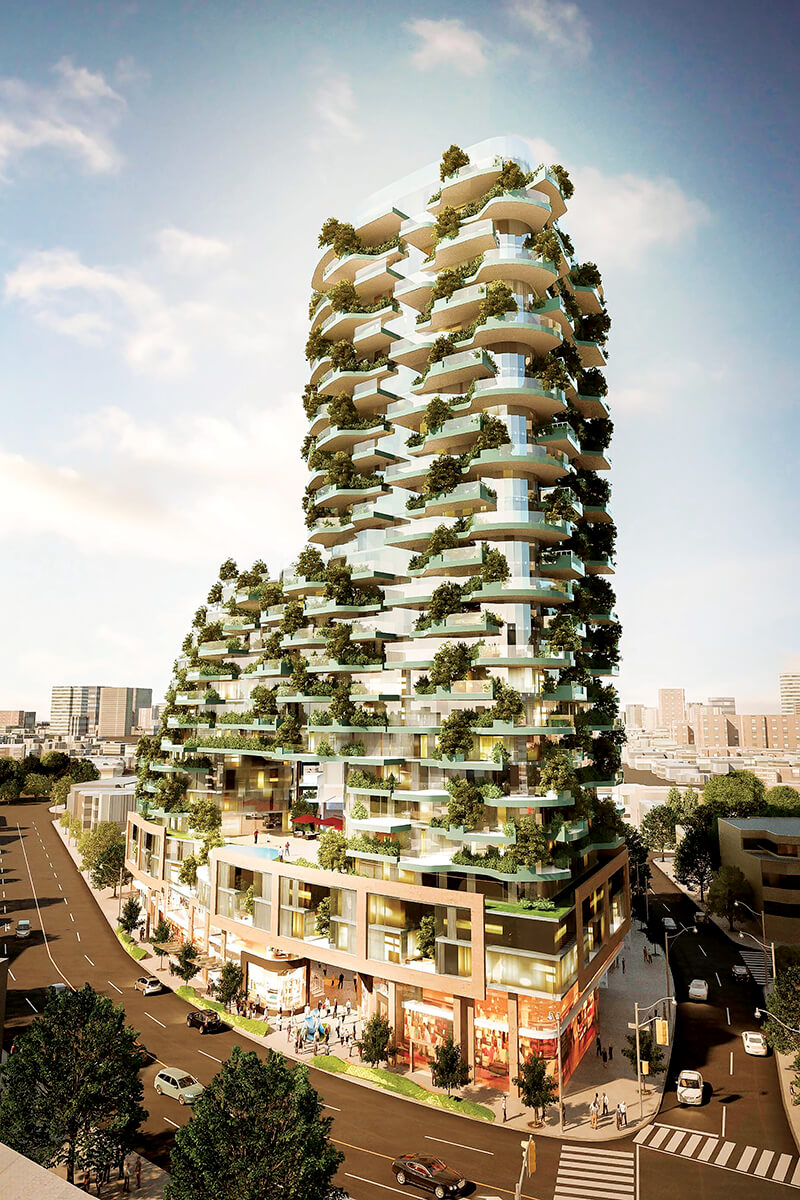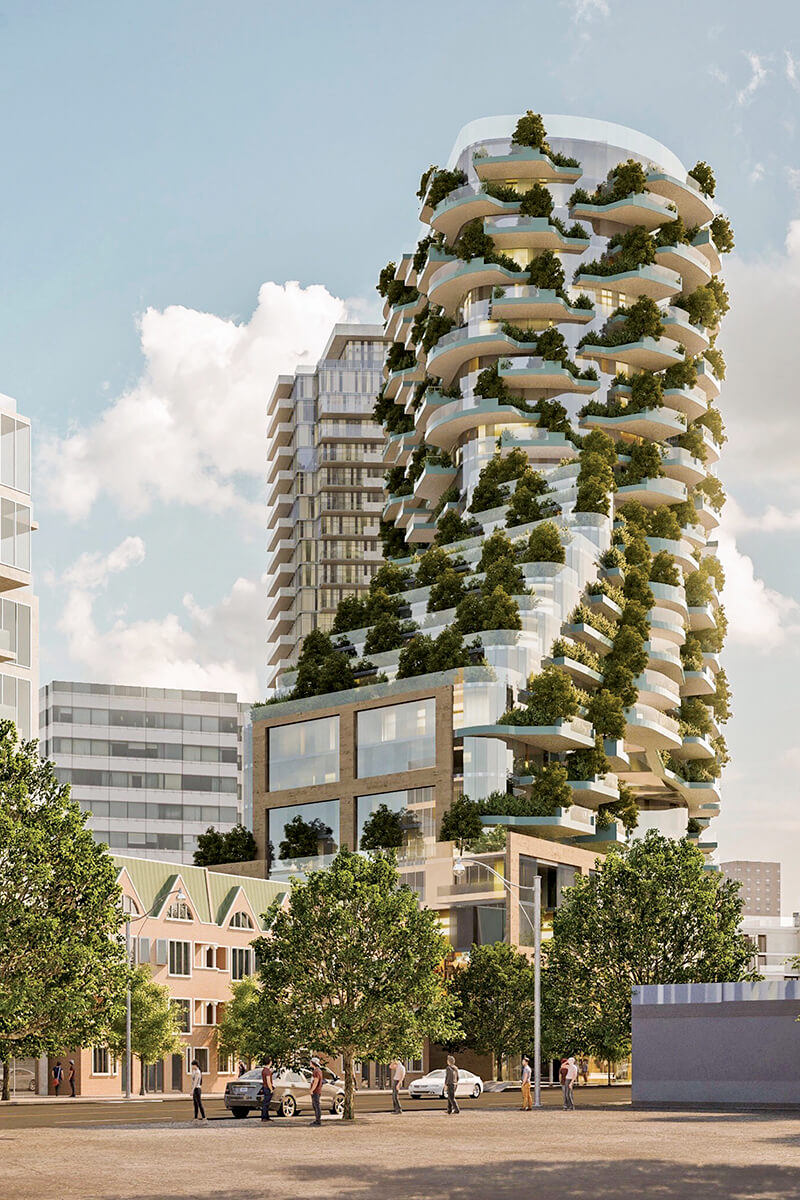January 14, 2019

Condo sprouts trees!
Design-forward Toronto project aims to plant a vertical forest
BY SCOTT BARBERAn architect firm and condo developer are planning Canada’s first vertical forest for Toronto, and they’ve brought together an impressive team of horticulturists, arborists, irrigation specialists and academics to make the ambitious project come to life.
Cityzen Development Group and Brisbin Brook Beynon Architects, both based in Toronto, Ont., are working through the municipal approval process for Designers Walk, situated between the city’s posh Yorkville and Annex neighbourhoods.
If the project is approved as planned, the “L” shaped, 27-story building will be home to some 500 trees (half deciduous, half coniferous) on extensive terraces and an open parkette.
Artist renderings of the condo highlight just how unique this building would be in Toronto, a city which is increasingly dominated by cookie-cutter glass boxes. The images capture the imagination; as cities grow and population density increases, who wouldn’t prefer a green building over the monotony of glass and steel?
But is it really possible?
Robert Wright, dean of forestry at the University of Toronto, and a landscape architect by training, has been in discussions with Brian Brisbin of BBB.“People who understand ecological and horticultural environments know that these are living systems, and while you can do a whole lot with them, they are also quite unforgiving,” Wright said. “If you do it wrong, they will die.”
To build and maintain suitable environments for plants and trees of this scale, on a condo of this size, with exposure in all four directions, will require incredible horticultural expertise, Wright says. However, he is optimistic that with the right group of academics, industry experts and researchers, Designers Walk could serve as a model for future developments.
“My three drivers have always been biomass, biodiversity and canopy cover,” Wright says. “We need more trees, we need more vegetation and we need more green spaces in our cities, and I’m willing to consider just about anything to get that done.”
In addition to Wright, BBB Architects are working with researcher Darby McGrath of the Vineland Research and Innovation Centre in the Niagara, Ont., region; Milton, Ont.-based nursery PAO Horticultural; Milton- and Delhi, Ont.-based irrigation firm Vanden Bussche Irrigation; and arborist Michael Ormston-Holloway of The Planning Partnership in Toronto.
“Brian [Brisbin] contacted us because of research we have been doing with tree planting along highways and in harsh urban conditions,” McGrath explained. “We are looking at this as a project that would address the horticultural requirements of these kinds of environments as well as hopefully creating a kind of template for other people in Canada who want to use this type of building design.”
McGrath added, “There are a lot of challenges that we see right away with this project. The first thing that comes to mind for me as a tree person is the substrate quality and volume that the trees would have access to. I work in a lot of urban soils and we know that it is a primary determinant to the success of tree installations in cities. Finding the right air and water balance in the soil is hard enough on the ground in an urban setting, but trying to achieve it up in the air where the trees are experiencing potentially higher rates of evapotranspiration because of wind and heat and of all of the conditions that are different up on the side of a building, the substrate mix and the volume is going to be important.”
All that soil, plants and water will require structural engineering solutions, as well.
New opportunities for growers
McGrath says vertical forests could be a major opportunity for Canadian nursery growers and landscape professionals, including the potential for new nursery products suited to the application.“For Vineland, we look at this as a horticultural challenge and it’s our job to come up with innovations for the horticulture industry,” McGrath said. “It’s an opportunity to show the stewardship that we have over green space as nursery growers and landscapers.”
McGrath explained that funding for Vineland’s involvement will come in part from investments from the architect and the developer, and the organization will also be looking for public grants.
There are current examples of vertical forests in China, Singapore and Italy. The Bosco Verticale building in Milan, Italy, provided inspiration for Designers Walk. BBB Architects partner Brian Brisbin went as far as to rent a unit in the building through AirBNB to get a closer look.
The experienced led to an epiphany of sorts, he told the Toronto Star in a July, 2018 story. He had travelled to Europe, “to track down technology that’s about four miles from [his Toronto office].” The innovations that make a vertical forest possible — irrigation technology, advanced research into soil quality and volumes, leading urban forestry academics — are all found in the Greater Toronto Area.
“Our structure has depressed slab areas that hold the trees in with irrigation components built all into one specialized system, which has never been done before,” Brisbin told The Star.
To serve water needs, the building will have a filtering and recycling system that will pump water horizontally and vertically to each planter. Brisbin also told The Star that each tree will be computer monitored “for health and hydration in a program by the University of Toronto with Vineland Research and Innovation, providing a case study over the next five to 10 years that will set the base parameters for future buildings.”
_(1)-19-web.jpg) The health and environmental benefits of vertical forests has already been proven in places like China and Italy. (At right): Conserving...recycling reclaimed irrigation system...trees and green absorb noise, pollution and add O2.
The health and environmental benefits of vertical forests has already been proven in places like China and Italy. (At right): Conserving...recycling reclaimed irrigation system...trees and green absorb noise, pollution and add O2.
Challenges of our Canadian climate
However, Toronto’s climate poses additional challenges. “Toronto goes from minus 30 to plus 30 [degrees Celsius] in a single season,” Wright said. “You go to Milan, or Singapore or any of the places where there are these kinds of developments, and they all have very even climate profiles. Our profile has wild swings.”Wright emphasized the importance of a long-term maintenance plan developed and implemented by highly skilled and knowledgeable horticulturists.
“One of the big things I keep hitting [the architect firm] on is in landscaping we often see a lot of money spent on capital to
create amazing things, but not enough is done for long-term maintenance … this is the type of project that needs to have associated long-term maintenance contracts … It will require a great horticultural understanding of plant material; in a forest environment, the access to light is fairly equal because the trees are more or less on an equal playing field, whereas with a building, you have four entirely different climatic systems at play.”
Trees and plants must be selected and maintained with each specific microclimate in mind. Plans call for the 500 trees to be rooted two years ahead of time in woven, stainless steel planters.
Once the condo is complete and the trees and plants have been installed, plans are in place to monitor and study how well they do. The larger goal, for both Wright and McGrath, is to gain knowledge that will enable even more condo developments across the country to incorporate plant material and trees into buildings.
While the Designers Walk condo — based on its location in one of the most expensive neighbourhoods in Toronto — will be out of reach for all but the most well-heeled Torontonians, its success is important to more than just its future residents. If it works, and the horticulture is sound, it could serve as a model that could push the needle in Canada’s development industry. And that would be a very positive outcome for Canadians, the environment and horticulture professions.
Landscape Trades, January 2019

